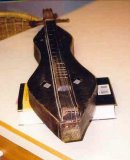"Reader response" is a both a literary theory and a way of teaching literature. According to Edgar V. Roberts and Henry E. Jacobs, edtiors of Literature (an imaginatively titled textbook we used to assign in English 112 at SCI), it allows "readers to bring their own personal reactions to literature, but it also aims to increase the discipline and skills of readers" (1967). How can you go wrong with that?
A lot of English teachers like reader response theory because it allows students more creativity than other approaches to literature. In reader response, you don't have to play like you're an expert when you're not and don't want to be. I also like it, especially in a course like Native American Cultural Studies, because it allows us to approach a work of art from a different culture and to examine our own cultural assumptions while we're doing it.
On the tip sheet linked to my faculty page, I've given you three questions to ask yourselves as you do a reader response: (1) What in the work jumps out at me? (2) What in my background makes me respond that way? (3) What passages in the work can I quote (or describe if it's music or visual art) analyze my response? Roberts and Jacobs suggest a similar approach:
The representative questions of the [reader response] theory are these: What does this work mean to me, in my present intellectual and moral makeup? What particular aspects of my life can help me understand and appreciate the work? How can the work improve my understanding and widen my insights? How can my increasing understanding help me understand the work more deeply? The theory is that the free interchange or transaction that such questions bring about leads toward interest and growth so that readers can assimilate literary works and accept them as part of their lives. (1966-67)There is a lot of good stuff on the internet, too.
One essay I've returned to several times over the years is by David S. Miall of the University of Alberta in Canada. It's entitled "Empowering the Reader: Literary Response and Classroom Learning" (click on "Online Essays," and open the seventh item in the directory). Miall explains how you reader response can help you hang onto some of the enjoyment of literature while writing about it for a class. He has a subsection titled "Which would you prefer: A trip to the dentist or doing some poetry?" (Surveys he did at Alberta might suggest good news for dentists!) Most important, he has some advice for people who are responding to a text in a classroom setting:
Given a new text, such as a poem, students might start by being asked to notice the most immediately striking aspects of the text: what, for them, stands out, seems interesting or puzzling, or feels different. A class of students undertaking this task will pick out much of the foregrounding [by which he means "stylistic high points" like images, themes, imaginative use of language] in the text, even though they may not recognize what specific features they are responding to, such as alliteration, or a metaphor. Secondly, students can be set to examine how the features they have noticed repeat, contrast, or otherwise relate; they can begin to articulate how the text seems to divide into larger sections, and how the sections as a whole might be characterized. So far, then, students will have picked out significant foregrounding, and begun to build a sense of the form of the text. Both these activities are enhanced by putting students together in small groups where they can compare their findings and discuss agreements and disagreements; at this stage, students often learn more from each other than they would from the instructor.

